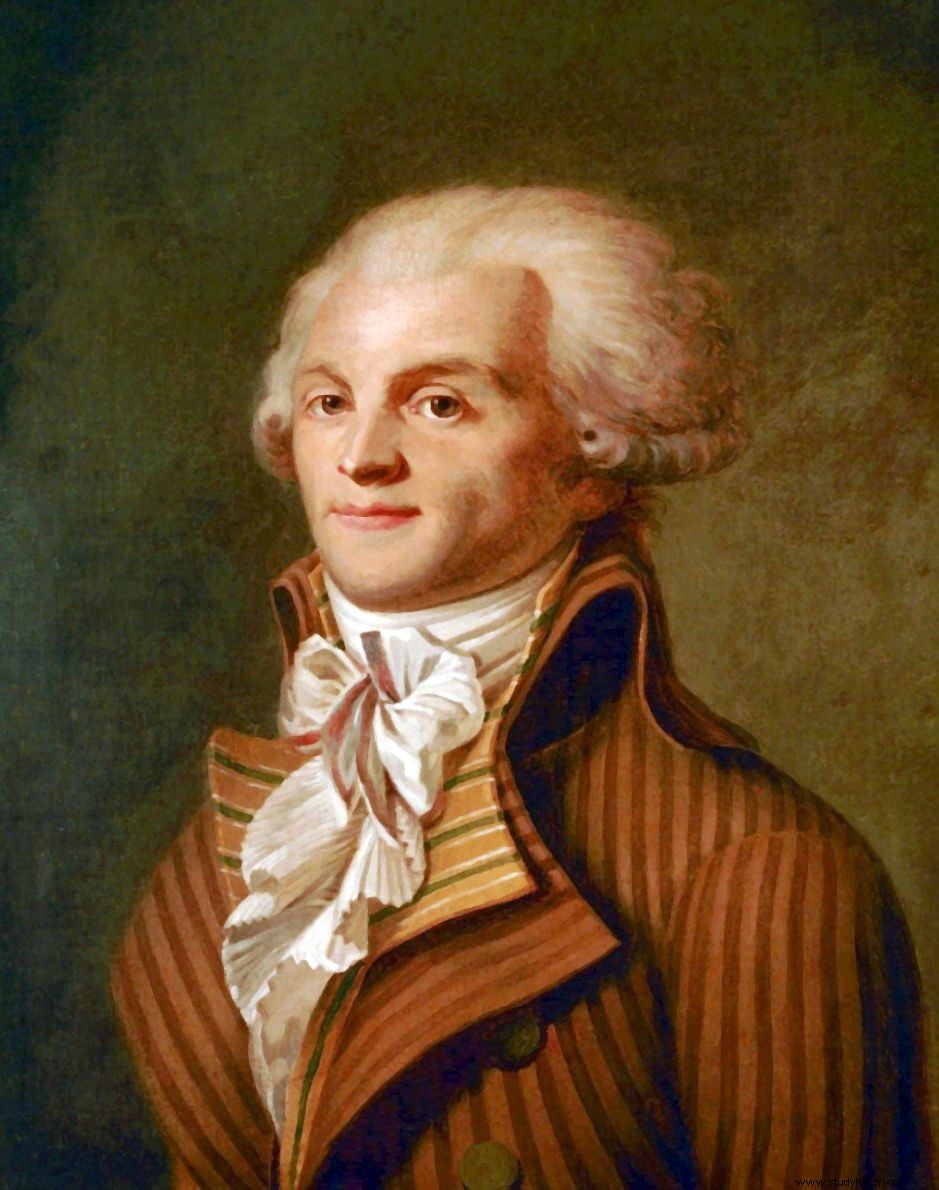He had a reputation as incorruptible. There were legends about his integrity. This lifelong image collapsed ... in just 24 hours. What was enough to say to knock someone off the top so quickly and send them to the guillotine?
The fall of Maximilian Robespierre, which took place on the 9th of Thermidor in the second year (i.e. June 27, 1794), was as violent as it was unpredictable. A gifted lawyer, who owed his meteoric career to the French Revolution, had been on the Public Salvation Committee for exactly one year.
It was a special body established to deal with the crisis situation in which France found itself caught up in war and revolution. He had more powers than a "normal" government - with Robespierre serving as an informal leader.
Incorruptible
His position seemed unmovable. Incorruptible, it was said of him. In the eyes of many of his contemporaries, Robespierre was nothing less than the embodiment of the French Revolution, its ideals of freedom, equality and democracy. This image will survive in some circles long after his death. Socialist Louis Blanc will report his fall almost like the way of the cross of the "new Christ".

Robespierre had a reputation as incorruptible. And yet the people of Paris immediately believed that he wanted to restore the monarchy in France and even make himself king! (source:public domain).
But he was identified not only with what was good and progressive in the revolution. Robespierre aroused widespread fear as a spokesman for the Great Terror. He dealt ruthlessly with the enemies of the Republic - or, more precisely, with whom he believed they were. The guillotine under his rule worked practically non-stop. The number of daily executions continued to increase, culminating in June and July 1794. Everyone could have been put under the knife, including women and children - among the 61 people executed on the 29th prairial (June 17) was the entire Sainte-Amaranthe family ! A gloomy record was set on the 19th of Messidor (July 7), when 67 people were beheaded.
During this period, attempts to bring down the reputation of the Jacobin leader seemed to be devoid of success. Of course, this did not discourage everyone. In June, on the wave of the impression caused by Robespierre's fight against atheism (he carried out a decree introducing the cult of the Supreme Being), they wanted to accuse him, for example, of ... participating in the "Theos" sect, which was to prepare the field for the coming of the new Messiah.
After the arrest of the group's central figure, Cathérine Théot (the name Theos was derived from the distortion of her surname), a letter of congratulations to the Incorruptible, paving the way for God's Son, was found at her home. Théot herself believed that she would be the new incarnation of the virgin Mary - even though she was already approaching eighty.
Two deputies to the Convention (and thus the revolutionary parliament), Jean-Lambert Tallien and Joseph Fouché, were most likely behind the accusations of participation in the sect. Robespierre suspected them of corruption, so they began to fear for their own skin. However, the head of the Public Salvation Committee left the case without prejudice to the opinion. Perhaps the rumor with which they wanted to fight him at the time was not successful enough yet?
Tyrant!
The situation changed dramatically in just two days. On the 8th of Thermidor (July 26), at a meeting of the Robespierre Convention, he announced that he was preparing new purges - and in his immediate vicinity! There is a conspiracy against public freedom - he announced - a coalition that plots even within the Convention . He found that some members of the Public Salvation Committee were also on board. His recipe was simple:the PEC, like the Common Security Committee operating in parallel, must clean, and the "rotten" elements must be eliminated.
It seems he has gone too far this time. The members of the Convention, faced with the threat to their own position (and probably even their lives), dared to resist the Untrustworthy. The next day's assembly did not take favor of his plan. Robespierre himself was also attacked, so far practically untouchable. "Tyrant!" exclaimed as the first MP from the Paris region, Jacques-Nicolas Billaud-Varenne.

The news of Robespierre's arrest caused real riots in Paris, as shown in drawing by F.-J. Harriet (photo by Rama, license CC BY-SA 2.0 FR).
In the blindly cast accusations, suggestions of the royalist sympathies of the former "apostle" of the Republic also began to appear. In the language of the revolution, they meant an accusation of treason. After all, it was the overthrow of the monarchy and the building of a new system that constituted the main goals of the entire French Revolution. Later that day, a decision was made to arrest three Jacobin leaders:Robespierre, Louis-Antoine Saint-Juste and Georges Couthon. Maximilian's brother Augustyn and Philippe Le Bas voluntarily joined them.
Nobody, however, expected how much resonance these, for the time being, rather reserved slanders would find in the uproarious city of Paris. The news of the detention of Incorruptible and his associates caused a real riot:the crowd tried to prevent the Convention from carrying out its decision. Meanwhile, twenty-four hours later, when Robespierre was sentenced to death, the "royalist" and "tyrant" sounded almost endearing compared to the other insults thrown at him.
Seal with a lily
As Bronisław Baczko wrote in his book How to get out of Terror. Thermidor and the Revolution ”, the career made by the rumor of Robespierre's betrayal, is a real phenomenon. The rumor, which began to sprout timidly in the morning of the 9th thermidor, by the evening of that day had already assumed horrendous proportions. This is what Baczko himself describes its content:
Here are its immutable elements:Robespierre is a royalist; at last he was exposed (…). On this canvas, you improvise, add your own, add evidence. The versions of the rumor can be arranged in order from the simplest to the most complex:a seal with a lily flower was found in Robespierre (and / or in the Commune, among the police officers); two of them tried to free the "young Capet" from Temple; the five "bastards" were about to make him king; Robespierre is going to marry Capet's daughter and their wedding contract has already been signed.

In the afternoon the 9th Thermidor Robespierre was seriously injured, so for the 10th Thermidor meeting he was brought on a stretcher as shown in the image of L.-E. Melingue (photo:Rama, license CC BY-SA 2.0 FR).
Therefore, not one, but a number of conspiracy theories was associated with Nieprzekupny, the most radical of which accused him of wanting to win the royal throne for himself by marrying the imprisoned daughter of Louis XVI, Maria Theresa . Both Baczko, a researcher of the French Revolution and Jan Baszkiewicz, who specialized in the history of France, had no doubts that these slanders were sucked from the finger. As well as others, reported by Baszkiewicz:
Androns were told about Robespierre's "orgies" and his lovers (including the unfortunate Cecylia Renault). It was repeated that he intended to restore the monarchy and declare himself king (...). Even from the Convention tribunal, Barère talked about the same kind of Thermidor nonsense. The Girondist Louvet (he will return to the Convention soon) rightly stated in his memoirs that factions can come up with anything and believe everything.
Of particular surprise among these accusations is the recognition of the lover of the Jacobin boss Cecylia Renault, who recently, in May this year, was accused of… preparing an attack on him. For this crime - as contrived as the charges against Robespierre - she was sentenced to death and was part of a 61-strong group executed on the 29th prairial.

Soon there were more reports of the sexual promiscuity of the revolutionary leaders. In the Journal de Perlet, quoted by Baczek, only a few days later Robespierre and his associates were accused of ... "seizing" the house of the Duchess de Chimay located in Issa. What for? As it was written in the journal: It was there that conspiracies were knocked out to destroy freedom, it was there with Hanriot, Saint-Just and a few other partners the ruin of the people was cooked amid the noisiest orgies .
Unbelievable?
The events of the next day show how much a change took place as a result of absurd rumors in the opinion of MPs and the Parisian people about Robespierre. When the current leader of the Revolution appeared in the 10 Thermidor Convention (July 28), he was attacked with invectives. Quickly and without trial, he was sentenced to death (along with his companions). On the same day they were guillotined.
The crowd that escorted Robespierre to Republic Square did not spare him names and insults. Later, the reluctant mood gradually subsided (but not so much that Charles d'Héricault almost a century later did not portray the most famous Jacobin as an obnoxious, jealous megalomaniac who dreamed of institutionalizing Terror ). However, at the time of his death, Robespierre was a traitor to the revolution for Parisians, who prepared for them a new monarchy, perhaps even more dangerous than the previous one.

On the way to Republic Square, where a guillotine was waiting for him, Robespierre was accompanied by a crowd mocking his "royal" aspirations (source:public domain).
It is ironic that it was the rumor and the absurd accusation of a conspiracy that contributed to the fall of the dictator, who based his entire system of government on denouncing traitors. Few topics were as stubbornly and obsessively present in Robespierre's political rhetoric as conspiratorial intrigues - by Goeffrey Cubitt.
Or maybe this revolution should be treated symbolically? With Robespierre, a certain style of managing the revolution also collapsed. The beheading of Jacobin leaders in a few Thermidorian days was the final act of the Great Terror. The new team already ruled in a different, less fear-filled atmosphere. In this sense, it was a turning point for the revolution. Not the right end yet, but as François Furet emphasized - the end of its pure form .
